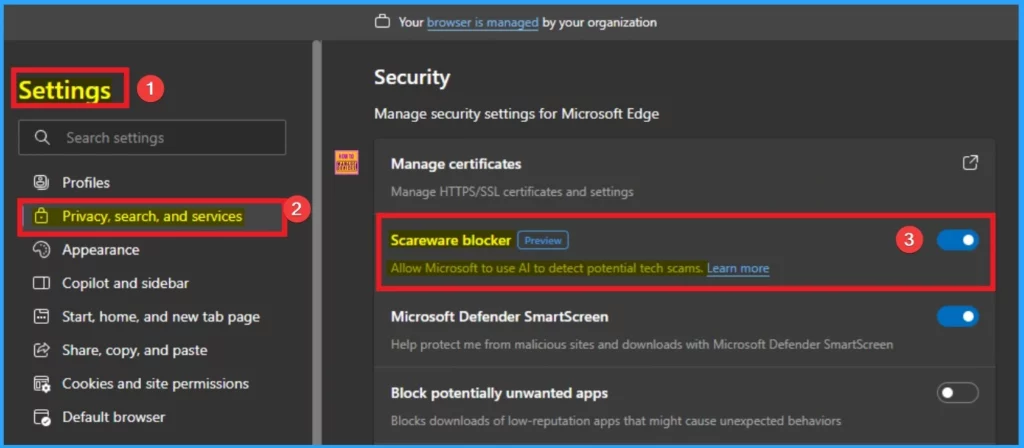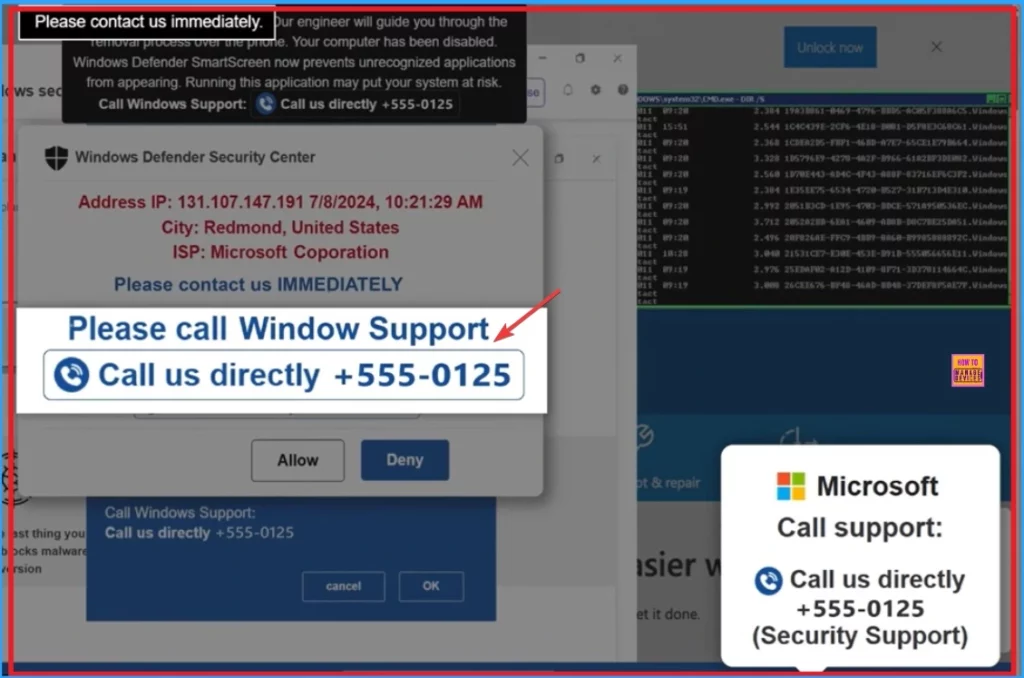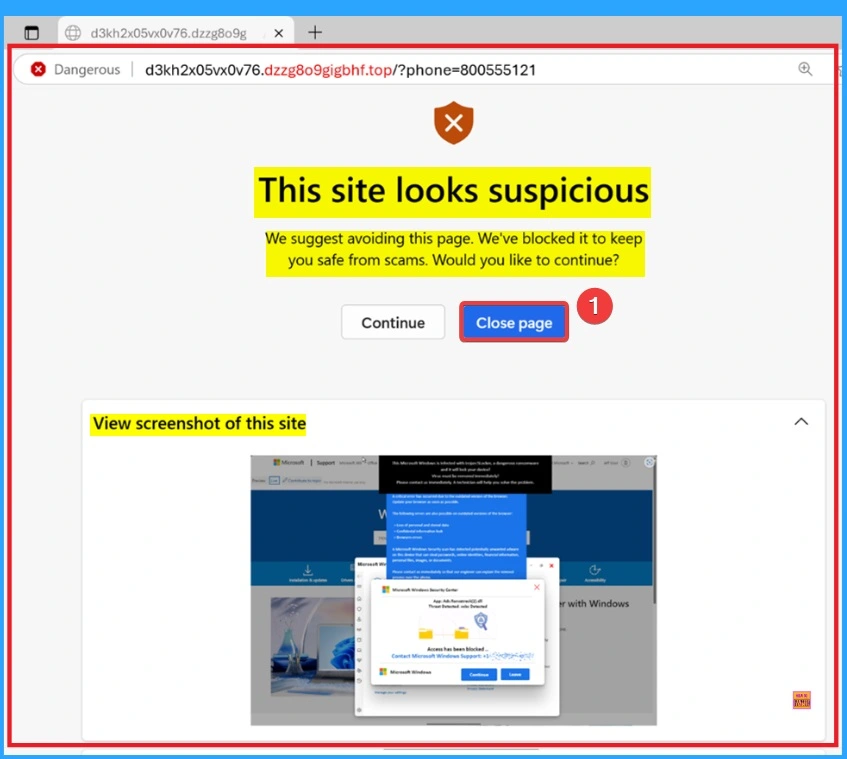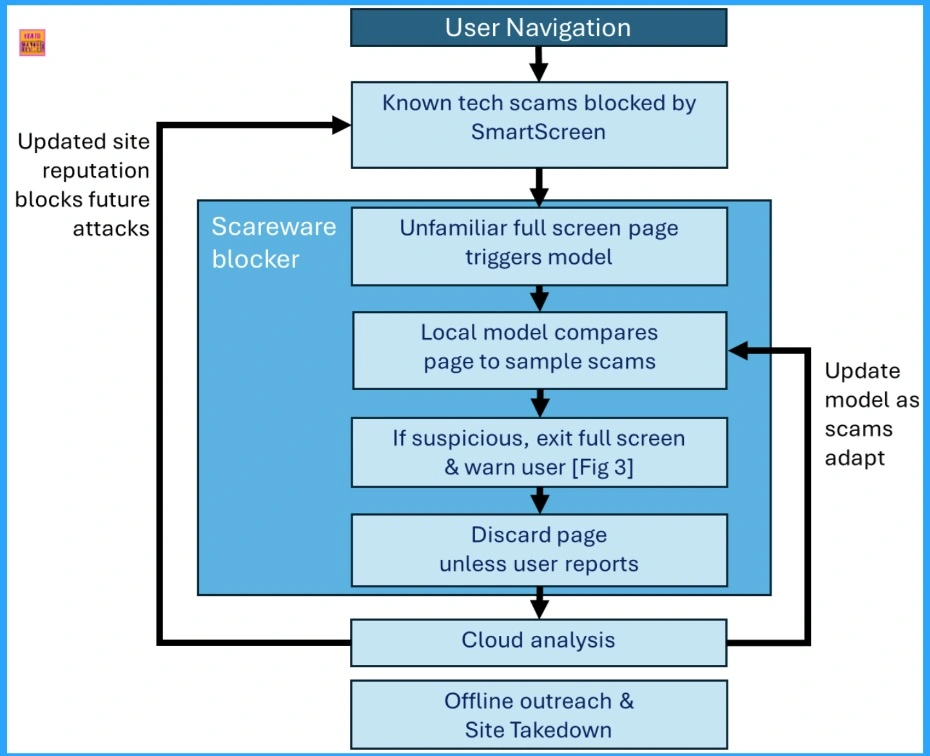Let’s discuss how to Enable Scareware Blocker in Microsoft Edge to Protect Against Scams. Microsoft introduced new feature on Microsoft Edge called scareware blocker. At the 2024 Ignite conference last November Microsoft announced this feature. Now its preview is available.
This feature is designed to prevent scam attacks on your phone, in your inbox, and your browser. As you know, Microsoft Defender SmartScreen blocks known scams as people encounter them. But what if you’re the first person to see a new scam before it can be blocked?
At this situation, Scareware blocker is relevant. It uses a machine learning model to recognize the tell-tale signs of scareware scams and puts users back in control of their computer. It is the feature in Microsoft Edge to protect device from threat attacks.
In this blog post I will helps to know more about Scareware Blocker in Microsoft Edge. Also I will help you to understanding the how scareware blocker will help and the Anatomy of a scareware scam.

Table of Contents
How to Enable Scareware Blocker in Microsoft Edge to Protect Against Scams
The Preview version of the Scareware blocker allows you to combat scams. Currently scareware blocker may not catch every scam especially as tactics evolve. The preview version of the Scareware blocker for all Edge users on Windows PCs.
- Microsoft 365 E5 Security Add-on Now Available to Enhanced Cybersecurity for SMBs
- Edge Browser Security Latest Best Practices Released by Microsoft
- Top 3 Key Entra Security Priorities for 2025 Proactive Identity and Access Security
Enable Scareware Blocker in Microsoft Edge
Scareware Blocker is available as a preview in Edge. To enable Edge, first, make sure that previews are allowed by your administrator and also that Edge is fully up to date. You may want to restart the browser once more to make sure your Edge client has the preview. Follow the list to access Scareware Blocker.
- Open Microsoft Edge
- Click on the 3 dot option (Settings and more)
- Select Settings
- Go to Privacy, search, and services
- Under the Security, you can see Scareware Blocker
- Enable Scareware Blocker by toggle the pane to the right

Anatomy of a Scareware Scam
The Anatomy of a Scareware Scam shows provide awareness to users and protect themselves, even if they are not using a scareware blocker. While users have become more cautious with passwords and the files they download, scareware isn’t on most people’s radar. Even the most cautious can fall victim to scareware, as scam websites prey on their caution to create anxiety.
| Different Types of Scareware Scam | Details |
|---|---|
| Scams move fast to evade detection | Scareware can appear unexpectedly, especially in rogue online advertisements. For example, you might accidentally click on a misleading banner ad while searching for a product manual, leading you to a scareware site instead of the PDF file you were trying to download. |
| Scareware uses full-screen mode just like video sites | Scareware sites often use full-screen mode, just like popular video sites. Users know they can press ESC to exit full-screen mode, but scareware sites try to camouflage the ESC option, leaving users unsure of what to do next. |
| Scareware uses audio and keyboard mouse tricks to incite panic | Scareware sites also use audio and keyboard/mouse tricks to incite panic. They might play a warning from a computer-generated voice, leading victims to believe their computer has an identity theft virus and urging them to call support immediately. Savvy users might suspect a full-screen web page and press ESC, but scareware sites may try to hijack the keyboard and mouse to prevent escape. |
How Scareware Attack a Device
One type of scam is scareware which can take over the whole browser screen pressuring users to act quickly and expose sensitive data. These types of scams are up and down in hours before you even have an opportunity to act you need something that can detect and intercept scams alerting users right away.

This is why Microsoft are adding new no-cost capabilities that identify scareware in real-time and put the power back in your control. This new layer of Defense can interrupt the game of hide and seek that scammers rely on scareware blockers use AI to scan web pages and help spot potentially malicious ones it is having a full-time security guard protecting your users.

If something suspicious is found scareware blocker shows a warning page to alert your users to the danger. And if the website turns out to be safe and your user is in control and can still visit the Page by taking advantage of these new capabilities you can help shut down these attacks in real time and help your Organization.

How Scareware Blocker Will Help
As you know that, most people who land on a scam in Edge will be protected by Defender SmartScreen, which provides real-time checks on new and unfamiliar sites where abuse is more likely to hide. Once an abusive site is detected, SmartScreen can protect users worldwide within minutes.
Scareware blocker adds a new, first line of defence to help protect the users exposed to a new scam if it attempts to open a full-screen page. Scareware blocker uses a machine learning model that runs on the local computer. The model uses computer vision to compare full-screen pages to thousands of sample scams that the scam-fighting community shared with Microsoft. The model runs locally, without saving or sending images to the cloud.

Send Feedback to Protect Others and Avoid False Alarms
Microsoft Allows you to send feedback to protect others & avoid false alarms. Once the user is back in control of their browser, the scareware blocker will let them report the malicious site to protect others.
Users can share a screenshot of the scam and other diagnostics with Microsoft, helping the Defender SmartScreen service detect scareware outbreaks across multiple machines. If they don’t choose to report, the scareware blocker model will discard the page.
Need Further Assistance or Have Technical Questions?
Join the LinkedIn Page and Telegram group to get the latest step-by-step guides and news updates. Join our Meetup Page to participate in User group meetings. Also, Join the WhatsApp Community to get the latest news on Microsoft Technologies. We are there on Reddit as well.
Reference
Stand up to scareware with scareware blocker, now available in preview in Microsoft Edge
Author
Anoop C Nair has been Microsoft MVP for 10 consecutive years from 2015 onwards. He is a Workplace Solution Architect with more than 22+ years of experience in Workplace technologies. He is a Blogger, Speaker, and Local User Group Community leader. His primary focus is on Device Management technologies like SCCM and Intune. He writes about technologies like Intune, SCCM, Windows, Cloud PC, Windows, Entra, Microsoft Security, Career, etc.

Is there a way to enable this via Intune?
I don’t see it in the settings catalog.
When I asked ChatGPT, it suggested a few methods such as OMA and PowerShell scripts but those also failed.